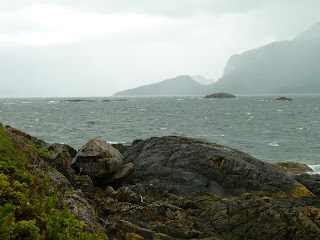01-27-2011
Day 39
Portage from Laguna San Rafael to Rio Negro
(Here you go Marcus!)
What would a kayak trip be without a portage? Indeed, one of the remarkable things about kayaks, besides being able to tuck into tiny nooks to camp for the night, is portability. The Isthmo de Ofqui is a route that was used for centuries by the Patagonian Indios to avoid paddling their canoes through the rough, exposed waters around the Peninsula de Taito. It has since been used by explorers and fishermen, and an attempt to build a canal was made back in the mid-1900s.
When we first began the permitting process with the Navy they thought we were planning to paddle the outside waters around the Peninsula and infamous Cabo Raper.
Here's what the Port Captain (in understated maritime terms) had to say about conditions on this open coast: "The open sea near Raper Lighthouse is normaly very bad with waves among 4 and 7 meters and winds between 25 to 45 knots."
No thank you. We'll take the portage.
 |
| Landing at the north side of the portage. |
 A vertical scar in the treeline of the southwestern coast of Laguna San Rafael clearly marks the beginning of the abandoned canal. The route through is comprised of sections of wet boggy ground alternating with bits of the old canal. In the dry places, old skid logs are still in place and allowed us to drag our empty boats without too much trouble. Eventually the old trail intersects the narrow, tannic waters of the upper Rio Negro. The land crossing is about 1.2 miles and took us 6 hours. We carried gear in two loads followed by the boats. So, in all, we hiked about 6 miles. Once in the rio, we followed the tiniest hint of current downstream where the river deepens and widens. From there it is all downstream through a tranquil riverine wilderness to the estuary where the Rio San Tadeo enters the Pacific. All the while the glaciers of the Patagonian Icecap loom in the background, wetland birds flit here and there, and snag trees stand like skeletons on the water's edge. Remote, wild, beautiful.
A vertical scar in the treeline of the southwestern coast of Laguna San Rafael clearly marks the beginning of the abandoned canal. The route through is comprised of sections of wet boggy ground alternating with bits of the old canal. In the dry places, old skid logs are still in place and allowed us to drag our empty boats without too much trouble. Eventually the old trail intersects the narrow, tannic waters of the upper Rio Negro. The land crossing is about 1.2 miles and took us 6 hours. We carried gear in two loads followed by the boats. So, in all, we hiked about 6 miles. Once in the rio, we followed the tiniest hint of current downstream where the river deepens and widens. From there it is all downstream through a tranquil riverine wilderness to the estuary where the Rio San Tadeo enters the Pacific. All the while the glaciers of the Patagonian Icecap loom in the background, wetland birds flit here and there, and snag trees stand like skeletons on the water's edge. Remote, wild, beautiful.
We completely enjoyed this peaceful paddling well aware that the next stage of the trip was likely to be the most strenuous, most technical, most difficult of the trip. Now poised on the shore of the Golfo de Penas, we're set for a week or more of coastal paddling fully exposed to the 3 to 4 meter swell of the open Pacific.
Camping on the 30km long Playa San Esteban is nothing short of sublime, surreal, awesome and the apprehensive knot in our stomachs only intensifies the experience.
Wish us luck!!


































